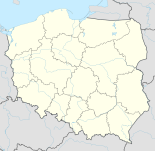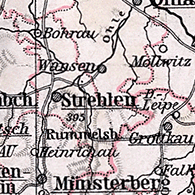Strzelin
| Strzelin | ||
|---|---|---|

|
|
|
| Basic data | ||
| State : | Poland | |
| Voivodeship : | Lower Silesia | |
| Powiat : | Strzelin | |
| Area : | 10.32 km² | |
| Geographic location : | 50 ° 47 ' N , 17 ° 4' E | |
| Height : | 173 m npm | |
| Residents : | 12,460 (Jun. 30, 2019) |
|
| Postal code : | 57-100 | |
| Telephone code : | (+48) 71 | |
| License plate : | DST | |
| Economy and Transport | ||
| Street : | Dzierżoniów - Brzeg | |
| Rail route : | Wroclaw – Kamieniec Ząbkowicki | |
| Next international airport : | Wroclaw | |
| Gmina | ||
| Gminatype: | Urban and rural municipality | |
| Gmina structure: | 45 villages | |
| 36 school offices | ||
| Surface: | 171.69 km² | |
| Residents: | 22,167 (Jun. 30, 2019) |
|
| Population density : | 129 inhabitants / km² | |
| Community number ( GUS ): | 0217043 | |
| Administration (as of 2011) | ||
| Mayor : | Dorota Pawnuk | |
| Address: | ul.Ząbkowicka 11 57-100 Strzelin |
|
| Website : | www.strzelin.pl | |
Strzelin [ ˈstʃɛlin ] ( German Strehlen ) is a city in the Polish Voivodeship of Lower Silesia . It is also the seat of the Powiat Strzeliński ( Strehlen district ). The granite quarries in Strzelin are among the largest in Europe.
Geographical location

The city is located in Lower Silesia on the Ohle at the foot of the Strehlener Mountains ( Wzgórza Strzelinskie ), about 40 kilometers south of Wroclaw .
history
Strehlen received German town rights in 1293 from Duke Boleslaw I of Schweidnitz .
Since the 18th century, Strehlen and its surroundings have been home to an important ethnic minority of Czech-speaking religious refugees and settlers from Bohemia . The place Hussinetz (today: Gęsiniec ) in the district of Strehlen was the most important settlement of these successors of the communities of Jan Hus .
Around 1900 Strehlen had two Protestant, one Old Lutheran and one Catholic churches, a synagogue, a district court and a grammar school.
Until 1945 Strehlen was the administrative seat of the district Strehlen in the administrative district of Breslau in the Prussian province of Lower Silesia of the German Reich .
In January 1945 Strehlen suffered the first air raids, in which the railway junction was the main target. In mid-March the Red Army advanced towards Strehlen. Then there was heavy fighting around the city. Shortly before the end of the fighting, the German Wehrmacht had the towers in the old town, including the town hall tower, blown up on March 24, 1945. When the fighting ended, the entire city was almost destroyed. Only individual fragments of buildings have been preserved. The city's population had been evacuated before the Red Army arrived. After the end of the war, the city was placed under Polish administration by the Soviet occupying power, along with almost all of Silesia . The Poles introduced the place name Strzelin for Strehlen . As far as German residents were still present, they were subsequently expelled from Strehlen by the local Polish administrative authority .
- Population development
| year | Residents | Remarks |
|---|---|---|
| 1840 | 4,260 | 1987 male and 2273 female residents; 710 married couples; 3,035 Evangelicals, 1139 Catholics and 86 Jews |
| 1844 | 4,253 | thereof 1965 male and 2288 female residents; 706 married couples; 3,050 Evangelicals, 1109 Catholics and 94 Jews |
| 1875 | 6,289 | |
| 1880 | 7,261 | |
| 1890 | 9,016 | of which 6,471 Protestants, 2,433 Catholics and 108 Jews |
| 1905 | 8,999 | including 2,433 Catholics and 64 Jews. |
| 1925 | 10.142 | of which 7,422 Protestants, 2,578 Catholics, eight other Christians, 59 Jews |
| 1933 | 11,364 | of which 8,488 Protestants, 2,643 Catholics, one other Christian, 51 Jews |
| 1939 | 12,290 | thereof 9,110 Evangelicals, 2,904 Catholics, 34 other Christians, 14 Jews |
Attractions
- The Church of the Holy Cross at ul. Sw. Floriana was built between 1700 and 1721. After severe war damage, the church was rebuilt.
- The Church of Our Lady was built in 1750 and rebuilt in 1979 after being severely damaged during the war. It is located on Staromiejska Street.
- The St. Gotthard Church was built in the 14th and 15th centuries. The tower dates from the 12th century.
- The town hall tower , built in 1520, forms the last remains of the town hall on the Ring, which was destroyed in 1945. Blown up in 1945 by the German Wehrmacht, only the first two floors stood on the square for decades. The original reconstruction of the tower took place in 2011.
- The house of the Brieger princes was destroyed in 1945. Only the outer walls were preserved. In the 1990s, the building was rebuilt true to the original.
- Entrance building of the main station from 1896
- Remains of the medieval city wall from 1300
- Jewish Cemetery
- Post office
local community
The urban and rural community ( gmina miejsko-wiejska ) includes the town of Strzelin and the following 36 districts ( official German names until 1945 ) with a Schulzenamt :
- Kryniczno
- Biały Kościół ( Stone Church )
- Biedrzychów ( Friedersdorf )
- Bierzyn ( Barzdorf )
- Brożec ( Brosewitz )
- Chociwel ( Kuschlau )
- Częszyce ( Tschanschwitz , 1937–1945 Ohletal )
- Dankowice ( Danchwitz )
- Dębniki ( oak forest )
- Dobrogoszcz ( Dobergast )
- Gębice ( Gambitz and Neu Karlsdorf , 1937–1945 Karlsdorf )
- Gębczyce ( Geppersdorf )
- Gęsiniec ( Hussinetz , 1937–1945 Friedrichstein )
- Głęboka ( Glambach )
- Gościęcice ( Mehltheuer-Podiebrad , 1937–1945 Mehltheuer )
- Górzec ( Gurtsch )
- Karszów ( Karschau )
- Karszówek ( Karish )
- Kazanów ( Schildberg )
- Krzepice ( Krippitz )
- Kuropatnik ( Töppendorf )
- Ludów Polski ( Klein Lauden )
- Mikoszów ( Niklasdorf )
- Muchowiec ( Mückendorf )
- Nieszkowice ( Neobschütz , 1937–1945 Kaltwassertal )
- Nowolesie ( Waldneudorf )
- Pęcz ( Pentsch )
- Piotrowice ( Peterwitz )
- Pławna ( Plohe )
- Skoroszowice ( Korschwitz )
- Strzegów ( Striga )
- Szczawin ( Saegen )
- Szczodrowice ( dewlaps )
- Trześnie ( Birkkretscham )
- Warkocz ( Warkotsch , 1937–1945 Friedfelde )
- Wąwolnica ( Wammelwitz )
- Żeleźnik ( Eisenberg )
Other localities in the municipality without the Schulzenamt are:
- Gliczyna
- Góra
- Grabiny
- Kaczów
- Maszyce
- Mojków
- Myszkowice
- Plo ( Plohmühle )
- Ulica
- Zimne Doły
traffic
Strzelin station is located at the intersection of the Wrocław – Międzylesie railway with the disused Brzeg – Łagiewniki Dzierżoniowskie railway . The Grodków Śląski – Głęboka Śląska railway used to end in the station in Głęboka on the latter line .
Sports
The Strzelinianka Strzelin football club is based in the city .
Personalities
sons and daughters of the town
- Johann Christian Tralles (1652–1698), German physician and city physician in Breslau
- Johann Gottlieb Blümner (1763–1837), Rendant at the Higher Regional Court in Breslau
- Moritz Pläschke (1817–1888), German genre painter from the Düsseldorf School
- Heřman z Tardy (1832–1917), reformed pastor and senior church councilor
- Johannes Athanasius Kopietz (1843–?), German historian and educator
- Paul Ehrlich (1854–1915), German doctor and chemist, Nobel Prize winner
- Samuel Traugott Milsch (1780–1846), German educator and pastor
- Carl von Dobschütz (1861–1946), Prussian general
- Fritz Klingmüller (1871–1939), German law scholar and university professor
- Herbert von Richthofen (1879–1952), German diplomat
- Fritz Neumann-Hegenberg (1884–1924), German painter
- Herbert Goldschmidt (1890–1943), Magdeburg local politician
- Fred G. Hellwig (1919–1992), blacksmith, sculptor, medalist and industrial designer
- Norbert Raba (* 1973), Polish politician
Personalities who have worked on site
- Gottfried Ferdinand von Buckisch and Löwenfels (1641–1699), German lawyer and church historian, was a councilor in Strehlen from 1670 to 1676
- Franz Xaver Görlich (1801–1881), Catholic clergyman, educator and writer, worked as a pastor in Strehlen from 1842–1857
Town twinning
-
 Sögel , Germany
Sögel , Germany -
 Vlagtwedde , Netherlands
Vlagtwedde , Netherlands -
 Pontoise , France
Pontoise , France
literature
- Franz Xaver Görlich : History of the city Strehlen in Prussian Silesia . Breslau 1853 ( e-copy ).
Web links
- Historical and current recordings as well as geographical location
- The destruction of Strehlen (Hans-Dieter Langer)
- Homepage of Strzelin (Polish)
Individual evidence
- ↑ a b population. Size and Structure by Territorial Division. As of June 30, 2019. Główny Urząd Statystyczny (GUS) (PDF files; 0.99 MiB), accessed December 24, 2019 .
- ↑ a b c Meyer's Large Conversation Lexicon . 6th edition, Volume 19, Leipzig and Vienna 1909, pp. 113–114.
- ↑ a b Destruction of Strehlen 1945 [1]
- ^ Strehlener Stadt-Blatt, No. 8 of February 20, 1841, digitized edition
- ^ Strehlener Kreis- und Stadt-Blatt, No. 6 of February 17, 1844, digitized edition
- ↑ a b c d e f Michael Rademacher: German administrative history from the unification of the empire in 1871 to the reunification in 1990. strehlen.html. (Online material for the dissertation, Osnabrück 2006).
- ^ House of the Dukes of Brzeg
- ↑ The Genealogical Place Directory
- ↑ [2]
- ↑ Life data according to German biography





